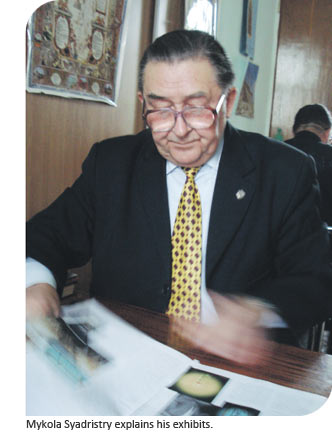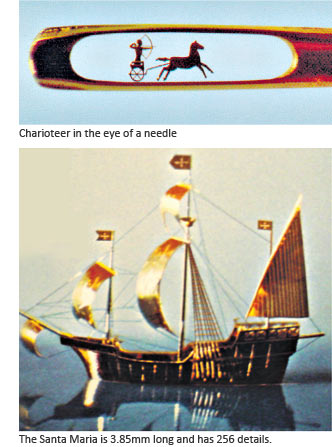  ykola Syadristy was eager to start. No sooner had my translator and I sat down in the small office above his permanent exhibition of micro art on the grounds of the Pechersk Lavra Monastery in Kyiv, than he launched into an impassioned presentation, barely allowing opportunities for questions. ykola Syadristy was eager to start. No sooner had my translator and I sat down in the small office above his permanent exhibition of micro art on the grounds of the Pechersk Lavra Monastery in Kyiv, than he launched into an impassioned presentation, barely allowing opportunities for questions.
His subject? History, not art. He was eager to let us know that his own interests were primarily focused on the facts of history, on delving into the truth from original documents, on going beyond the explanations of historians whom he believes distort the truth to please their political masters. Most important to him is the history of famine in Ukraine during the 1932-33 period.
Syadristy wants it known that although Stalin was in charge at the time of the famine, it was Lenin who had planned the whole thing before he died, almost a decade earlier. He shows us a book in Russian that appears to lay out the main dates of Lenin’s program to capture control of Russia and establish a communist state. The last step points to a major event, that Syadristy believes was the famine, or Holodomor, as it is called in Ukrainian.
To make his point, Syadristy has organized several exhibitions of newspaper clippings and other documentation of the disaster that befell Ukraine. He was also instrumental in helping Ukraine’s last president, Viktor Yushchenko, get a monument to the Holodomor erected on the banks of the Dnieper River, next to the Lavra, in Kyiv.
Eventually, the conversation turns to his art. He has pioneered a type of art that exists in a rarified world all of its own. There are some other micro artists in the world, but I doubt any has achieved the incredible levels of artistic skill demonstrated in Syadristy’s pieces.
His figures, from sailing ships and to ancient Egyptians and historical figures of past and present (among them Abraham Lincoln, Pope John Paul II and Yuri Gagarin) were all made under powerful microscopes and can only be seen using magnifying lenses. His preferred material is gold, although some busts or engraved faces are carved in sloe stone (the hard seeds of blackthorn shrubs) and poppy seeds.
His exhibition in Kyiv is a series of alcoves in each of which one piece of art is displayed, with special lighting and a magnifying lens, adjustable for focus, placed immediately in front of the art. What appears as a speck of gold to the naked eye, suddenly unfolds as an intricate piece of art when viewed through the lens.
To get an idea of the scale of his work, consider that typical pieces fit on the head of a pin or, smaller still, are etched into the cross-section of a human hair. In one piece, he hollowed out a hair and placed a rose within it. The diameter of the flower? Just 0.05 mm.
 Among the ships he used as models is the Santa Maria that carried Christopher Columbus to the Americas, and Russian author Alexander Grin’s red-sailed ship in the romantic fantasy by that name (the story was also made into a film by Mosfilm in 1961). Among the ships he used as models is the Santa Maria that carried Christopher Columbus to the Americas, and Russian author Alexander Grin’s red-sailed ship in the romantic fantasy by that name (the story was also made into a film by Mosfilm in 1961).
The red-sailed ship made by Syadristy is 3.5 mm long and has 337 details, made from gold, platinum and glass. The cross-section of the rigging is just 0.003 mm, making it 400 times thinner than human hair.
To work at this micro level, Syadristy would cut himself off from the world and work non-stop on a piece, from conception, to choice of materials, to final execution. The smallest details required him to move the tiny instruments he developed only when holding his breath and between heartbeats. One false move could destroy the whole piece. Typically, he would take a month to produce one piece.
He said he gets inspiration for pieces all the time, “just walking in the street”. During Soviet times, he made some clearly political artworks, including a portrait of Lenin with the lines and shading made up of microscopic words taken from Lenin’s writings. A similar portrait of Leonid Brezhnev was made in a similar way. You need a magnifying glass to see the letters.
Today, though, Syadristy will not be photographed with his Lenin piece, even though it hangs in a place of honor in his gallery. Remember, he blames Lenin for the Holodomor. He is less shy about being seen with his Brezhnev piece, and recounts how a meeting he had with the former Soviet leader, to present the piece to him, went from a scheduled 15 minutes to one-and-a-half hours. The original has since been destroyed, but he offers copies to certain guests.
Some of his other fantastic pieces include a chess set on top of a pin head; a horse and chariot with archer in the eye of a needle; the smallest book in the world, which – although only 0.6 mm square – has 12 pages of poetry by Taras Shevchenko, Ukraine’s most famous author; swallows and their chicks in a nest made of half a poppy seed; The Little Prince with a bi-plane, small boy and a globe, much like the cover of the original book by Antoine de Saint-Exupéry; a life-sized golden flea with golden crown and golden shoes; and so many others.
He has written 150 books, many on his latest passion, but the first was called Is it Difficult to Shoe a Flea? and talked about his art. The second was called The Secrets of Microtechnique and became a best seller in the Soviet Union.
But Syadristy is more interested in people than in depictions of them or other objects. “History is about people,” he says simply. And it is his passion for life and concern for people that has motivated him to pursue the truth about the Holodomor. Official histories are written by the winners, he notes, and often the winners are not the same as the good guys. Hence his criticism of the history-writing establishment which he believes has failed to cover Ukraine’s history honestly.
Born in Ukraine in 1937, Mykola (Nicolai in Russian) Syadristy first worked as an agronomist and then an engineer, before turning to art full-time in the second half of the 1970s. However, at the same time, starting in the early 1960s, he has made a point of gathering documents about important events in history that are of interest to him. He says he reads on average 1000 pages a day on these issues.
He says, “A person must be interested in everything.” If you only focus on one thing, you will make a lot of mistakes in life, he says. He sees his art as a fusion of modern science with poetry. Poetry, he says, comes from God. He sees it as resonating with what he calls the four core desires of man: to love and be loved, to create children, and to live as long as possible.
In his chosen field of art, success comes from knowing the characteristics of the materials he works with, “in the same way that you have to know the character of people you work with.”
And although he has exhibited his art in many cities around the world, he believes he will only be truly famous after his death. After creating some 100 pieces, he no longer works at his art, and his last piece was completed three years ago.
You can see more of his work at http://microart.kiev.ua/en.
|